Mechanical Aids to Computation and the Development of Algorithms
Dr. Paul E. Dunne
Dept. of Computer Science
(Room 3.10, Chadwick Tower)
e-mail ped@uk.ac.liv.csc
Introduction
-
What do people think about computers?
-
Why do they think it?
-
Are they right in thinking it?
-
What is Computer Science `actually' about?
Popular Beliefs
-
Computers can do anything
-
Computers make mistakes
-
Computers threaten society.
-
Computers benefit society
-
Computers are intelligent
-
Computers affect people's lives
-
Computers are difficult to understand
Computers can do anything
A `mathematical refutation' of this was given in 1936 by Alan Turing:
computers can only manipulate strings of symbols. If a task can be
expressed as a sequence of operations on a collection of symbol strings
then a computer may be programmed to perform the task. It may be proved
that certain tasks cannot be expressed in this way.
Computers make mistakes
Computers are inanimate tools used by individuals. People make
mistakes not machines.
Computers threaten/benefit society
This is a view that has been held about almost all new inventions, discoveries,
technologies. For example
-
The Luddite riots.
-
The portrayal of new ideas in literature, art, cinema:
-
Electricity in Shelley's Frankenstein.
-
Psychological theories in
-
Stevenson's Dr. Jekyll and Mr. Hyde
-
Surrealist painting and writing.
-
Mechanisation in general in:
-
Varese' composition Déserts; and Honegger's Pacific 231
-
Duchamp's `sculpture/painting' La mariée mise á nu par ses celibitaires, m&eme (Le Grand Verre)
-
Huxley's novel Brave New World
For the specific case of computers a common source of both utopian and
dystopian views is through cinema depictions, e.g.
-
Solaris (Tarkovsky, 1972)
-
THX 1138 (Lucas, 1970)
-
Alphaville (Godard, 1965)
-
Forbidden Planet (Wilcox, 1956)
-
2001 (Kubrick, 1968)
-
Billion Dollar Brain (Russell, 1967)
-
The Forbin Project (Sargent, 1969)
-
Demon Seed (Cammel, 1977)
Computers are intelligent
This common belief is based on fallacious reasoning promoted by non-Computer Scientists
and some Computer Science `experts'. Namely
-
Computers can (be programmed to) perform some tasks much `better' than humans.
-
Examples of such tasks are arithmetic and code breaking.
-
A human who is adept at these tasks is often regarded as `intelligent'.
-
Therefore, since computers are `good' at activities which are taken
as indicating intelligence in humans and can perform other tasks as well, it
follows that computers are intelligent.
Computers affect people's lives
One of the areas in which computer systems have become predominant in the
last 20 years is that of
Record storage and maintenance
Thus, in many areas, information on individuals is held on computer databases
-
Social Security details (D.S.S. at Newcastle)
-
Car registration (D.V.L.C. at Swansea)
-
Student records (Univ. of Liverpool)
-
Financial records (Banks, Credit agents)
-
Medical records (N.H.S.)
-
Car theft and crimes (P.N.C. at Hendon)
The widespread use of such sytems has caused concern on the grounds of
-
Confidential nature of information held.
-
Access by unauthorised individuals.
-
Errors in personal records.
-
Purposes for which information is held:
-
Employment blacklists
-
Membership of political/pressure groups.
-
Excess capacity of the P.N.C.
Some of these concerns have been addressed in 2 Acts of Parliament,
passed since 1984.
The Data Protection Act (1984)
-
Created the office of Data Protection Registrar
-
Made registration of personal record databases a legal requirement.
-
Gave individuals the right to inspect and have corrected databases on
which they could show that information relating to them was held.
One consequence has been the adoption of the practise of releasing
exam marks to students at the University of Liverpool.
The Computer Misuse Act (1990)
A Private Member's Bill sponsored by the Consertative M.P.,
Emma Nicholson.
-
Criminalised the act of obtaining unauthorised access to computer
systems for `unlawful' or `malicious' purposes, i.e. `hacking'
-
Provided for penalties of up to 5 years imprisonment and/or
unlimited fines.
-
Mixed success to date: one highly publicised acquital (October 1992);
6 months prison terms for two other hackers who pleaded guilty (February 1993)
What are Current Concerns
in Computer Science
We look at 3 areas (this is not exhaustive)
-
Artificial Intelligence.
-
Non-traditional computer forms.
-
Mathematical Theory of Computation.
Artificial Intelligence
First mooted by Alan Turing. Properly began in the mid-1950s with
the work of Minsky, McCarthy and others in the U.S.
Two main schools of thought:
-
To understand processes of thought and intelligence as computational phenomena.
-
To build systems which can perform some tasks at least as well as humans.
(A) has made little progress, although recently it has provided a stimulus
for interaction between Computer Science, Psychology, and Linguistics.
(B) has had some success in the area of Expert Systems.
Non-traditional Computers
(non-von Neuman machines)
A number of different subfields fall into this category:
-
Neural networks
-
Genetic algorithms.
-
Quantum computation
-
Parallel Computers.
(1) uses ideas from physiological models of the brain as a computing paradigm.
(2) exloits ideas from Biology and D.N.A. evolution.
(3) uses models from Quantum Physics as a computational approach.
(4) encompasses the first three and deals with the issue of designing machines in which
large numbers of computers operate together.
Mathematical Theory of Computation
Arguably the oldest area of Computer Science. There are three main areas of research.
-
Semantics of Programming.
-
Computability Theory.
-
Computational Complexity Theory.
(1) is concerned with the issue of devising calculi by which programs
may be mathematically proved to be correct.
(2) dates from 1900. It deals with the issue of what problems can be solved by
computers and which can be proven impossible to solve.
(3), in various forms, dates back to the 1930s. It is concerned with the question of
which problems can be solved efficiently by computer systems.
Lecture 2
Early Development of Algorithms
and
Mechanical Counting Aids
Many of the concerns underlying modern computer systems date back to
the earliest civilisations.
Computers manipulate data to produce a desired result
i.e. They transform given representations of information.
There are two important concepts in this description:
-
Representation
-
Transformation
The first deals with how specific items of information may be described in a `universally'
recognised form.
The second deals with the procedures (programs or algorithms)
which are used to transform such representations to produce a result.
An example of the second is the method taught in schools for carrying
out long multiplication.
Why, given a common means of representing information (e.g. numbers), and
procedures for manipulating such representations (e.g. multiplying, adding),
does one want to have mechanical help with performing the calculations?
Becuase such calculations as arise in practise are often involved and laborious.
Hence,
-
The calculation will take a long time to do.
-
There is great potential for error.
e.g. How would you prefer to calculate 123478474 times 6772366367? Would you trust
an answer that had been produced by hand using long multiplication?
The development of computational methods involved three areas:
-
The development of symbol representations of information that are easy to manipulate
-
The formulation of algorithms by which such representations could be processed
to solve computational problems.
-
The construction of mechanical tools that allowed such algorithms to be implemented in an
effcient and reliable way.
Number Representation

-
Common to many early cultures.
-
Simple to understand.
-
Addition, subtraction, multiplication relatively easy.
-
Extremely cumbersome for representing large numbers as might occur in
recording population sizes.
Tally system also introduces the idea of counting in multiples. 5 and 10 were
common choices. These hower were not universal
-
Mayan culture used 360 as a base
-
Babylonians used 60.
The influence of these two systems survives today, e.g. time measurement; angular
measurement.

-
Effectively no better than tally system.
-
Addition difficult, e.g.
CDXCIV + DVI = M
-
Multiplication extremely difficult.
Roman numerals survived in Europe until the 14th century when they replaced
by the Arab/Indian discovery of the decimal system
This used a symbol represent the number 0. (also a Mayan discovery)
Employed a positional notation.
Used 10 different symbols to represent the numbers 0 through 9
First popularised in Europe by Leonardo of Pisa
in his Liber Abaci (The Book of Computation) of 1228.
Early Computing Devices

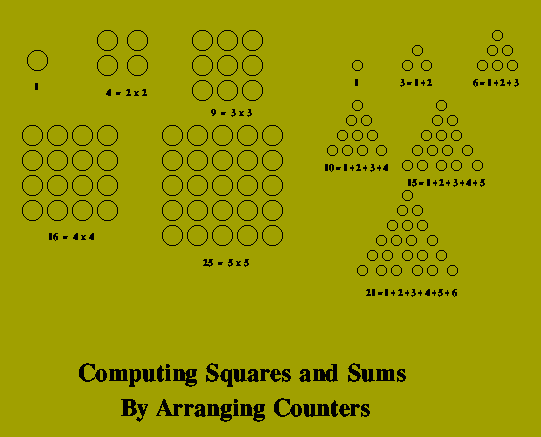
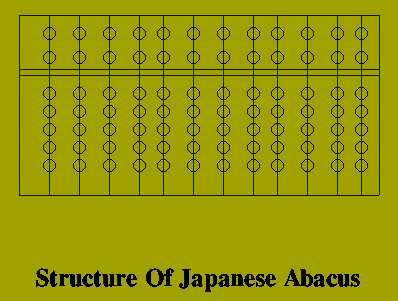
Euclid's concept of Algorithm
The Greek mathematician, Euclid (4th Century B.C) is the earliest known identifier of
specific algorithms
Euclid's work The Elements is of collection of results, mainly in Geometry.
-
It is the earliest known attempt to formalise the concept of algorithm, i.e. to separate `admissible'
computational processes from `inadmissible' ones.
-
Book VII, dedicated to properties of numbers, describes a number of important algorithms at least one
of which is still taught today.
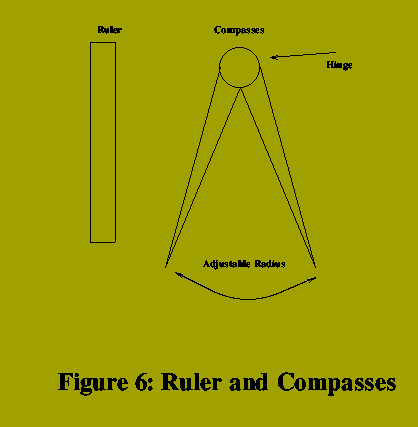
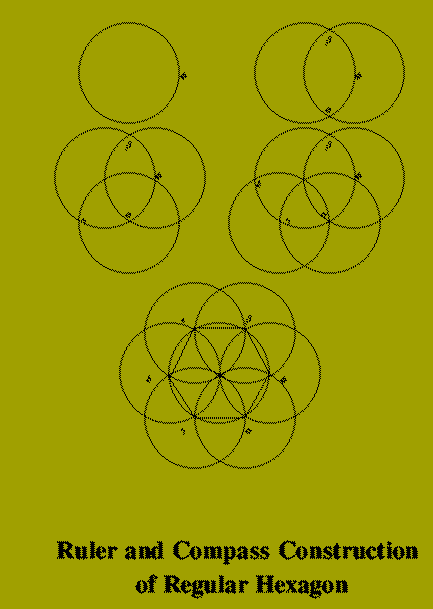
Although this may seem a very primitive class of algorithm, problems of great subtlety arise in it.
3 classical problems were not solved until over 2000 years after Euclid's death:
-
Trisecting an angle (proved impossible by Descartes in 1637)
-
Duplicating a cube (known to be impossible by Arab scholars)
-
Squaring the circle (finally proved to be impossible by Lindemann in 1882)
The second important contribution of The Elements is the algorithm to calculate the greatest
common divisor of two numbers.
greatest common divisor of m and n
1. If m is smaller than n then
swop the values of m and n.
2. Set m equal to the remainder of
m divided by n.
3. If m is not equal to 0 then
go back to step 1, with the
new values of n and m.
4. Return n as the answer.
.sp
Euclid's Algorithm
Euclid's work was not the only early investigation of algorithms. Another important Greek contribution
concerns a problem which is still very much of interest today em the generation of prime numbers.
The first algorithm to identify prime numbers is the famous Sieve of Eratosthenes (fl. 3rd Century B.C).
Write down all the numbers from 2 to n and then carry out the following steps:
1. Let k := 2
2. For each number, m, between k+1 and n
if m is an exact multiple of k then
cross m of the list of numbers.
3. Set k to be the smallest uncrossed
off number left.
4. If k is less than n then repeat
process from step (2).
5. Any number which has not been crossed off
is a prime number.
The Sieve of Eratosthenes
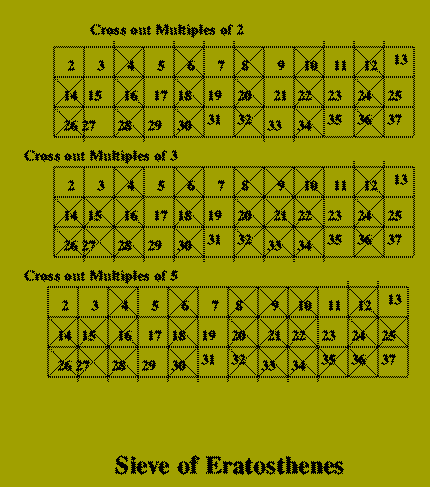
Lecture 3
16th - 18th Century
Development of
Mechanical Calculators
The adoption of the decimal system as a notation
for numbers simplified the problem of describing quantities.
This system, however, was not accompanied by corresponding
advances in calculating techniques.
From the 15th century onwards, a number of important areas
gave rises to numerical calculations of great complexity.
There was, however, little in the way of tools to help with
such calculations.
Three of the most important areas, in this respect, were:
-
Navigation.
-
Financial assessments, taxation etc.
-
Mechanics and Planetary motion
The first and third areas often gave rise to calculations involving
the evaluation of trigonometric functions, extraction of square and
cubic roots, and similarly advanced computations.
These were arising against a background in which the ability to
perform integer multiplication was extremely rare.
In this lecture we examine how improved methods of carrying out
complex arithmetic operations were developed. Such developments
may be placed into 2 groups:
-
Algorithmic approaches.
-
Mechanical Calculators.
In the former category we consider the work of 3 people:
-
John Napier, Baron of Merchiston (1550-1617).
-
Henry Briggs (1561-1631)
-
William Oughtred (1574-1660)
Logarithms
The technique of calculating via logarithms was described by Napier in the
paper Mirifici logarithmorum canonis descriptio of 1614.
Logarithms provide a mechanism for reducing multiplication and division
to the (relatively) simple operations of addition and subtraction.
A table of logarithms (to the base x) for some range of numbers
(1 to 100, say) is a list which gives for each value, n, a quantity
y called the logarithm of n to the base x (log^-x n). This
quantity has the property that x^y = n. Thus if x=10, log^-10 1000 = 3.
To perform multiplication of two numbers p and q, one finds logp and logq,
adds these values, and then look up the anti-logarithm of the result. That
this procedure is correct follows from the relationship
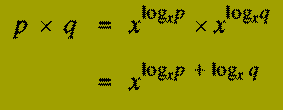
There are three problems with applying this approach:
-
One needs a table of logarithms and anti-logarithms to a particular base
to be available.
-
One has to be able to compute the logarithm of numbers not in the table.
-
For many calculations there will be small errors in the result (depending
on the accuracy of the tables)
The last drawback is acceptable, provided that the answers given are accurate
enough for the application of interest.
Napier described the technique of calculating with logarithms and provided
some basic tables which addressed the first problem.
The second difficulty was not easily dealt with by Napier's tables.
The reason for this is that Napier did not understand the concept of
base of a logarithm and his tables were constructed using the
constant 1/e.
e is a mathematical constant which has no simple physical definition: in
differential calculus e may be defined as the unique constant such that
the function e^x is its own derivative.
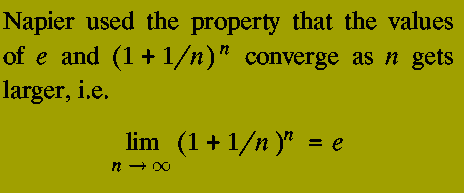
Napier, however, was not aware of this.
The first practical tables of logarithms (in the sense that
it was easy to construct the logarithms not in the table) were constructed
by Napier's English contemporary Henry Briggs.
Briggs discovered the idea of using 10 as the base.
Now, if one has a table between 1 and a 100, and one wishes to find
the log 1234 to the base 10, then one simply uses the fact that

A mechanical analogue of logarithms was the slide rule
invented by William Oughtred 1630.

Towards the end of his life, Napier invented a device which, for many years, was more highly
regarded than his researches concerning logarithms: a mechanism for simplifying the task of multiplying
numbers that has since become known as Napier's bones^9.
Napier's bones were, in effect, a clever representation of multiplication tables:
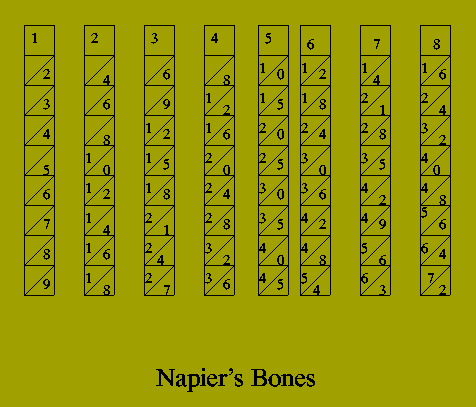
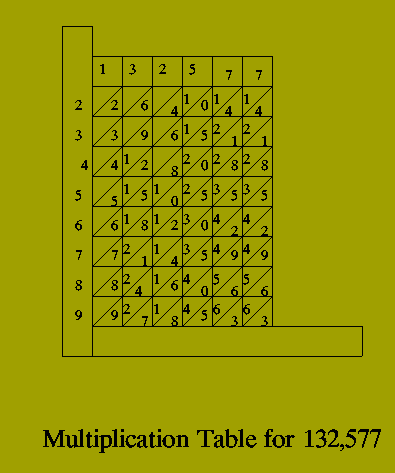
The First Mechanical Calculators
Between 1600 and 1700 a number of important mechanical calculating devices were
designed and built. The most significant achievements in this area were the
work of three people.
Unfortunately, Schickard's device, known as the Calculating Clock, met with
a problem:
-
I had placed an order with a local man, Johan Pfister, for the construction of a machine for
you: but when half-finished, this machine, together with some other things of mine, especially
several metal plates, fell victim to a fire which broke out unseen during the night ... I
take the loss very hard, now especially, since there is no time to produce a replacement soon.
The construction of the first mechanical calculator had been attributed to the French mathematician,
scientist and philosopher Blaise Pascal (1623-1662).
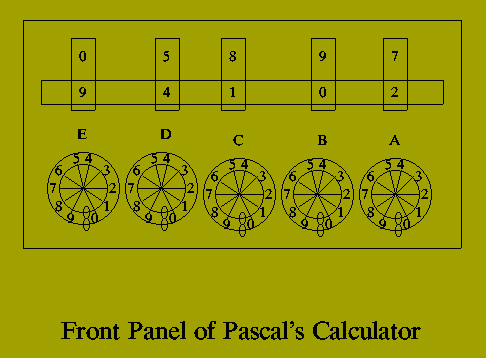
Gottfried Wilhelm von Leibniz em still noted today for his
contributions to mathematics, logic, philosophy and calculation and
the inventor of differential calculus in the form that it is known and
used today, invented a calculator known as the Stepped Reckoner.
This was an to build a machine
that could not only add and subtract automatically but could also multiply and divide
Leibniz solved the problem of multiplication by inventing a special type of gear, now called
the Leibniz Wheel.
Only one Stepped Reckoner is known to have been built.
There are two reasons for this lack of development:
-
the calculator was a highly intricate work
-
it didn't work.
Lecture 4
19th Century Work
Babbage, Hollerith, Boole
17th Century calculators demonstrated the feasibility of performing
arithmetic operations by machines.
They differed, however, from modern computers in a number of important
ways.
-
They were not programmable.
-
Computation was `memory less'.
-
Manual intervention was needed.
-
Technology was mechanical not electronic.
In the course of the 19th century all but the last of these points
were addressed in some way.
The principal contributions in this period were those of:
-
Joseph-Marie Jacquard (1752-1834)
-
Herman Hollerith (1860-1929)
-
Charles Babbage (1791-1871)
-
George Boole (1815-64)
Joseph-Marie Jacquard
Jacquard worked in the textile industry in France. Production of
patterned cloth during the 18th century was a time-consuming and
highly skilled task. Jacquard devised a mechanism em the Jacquard
Loom em by which complex patterns could be woven automatically.
To record a pattern and control the operation of a loom, a
Program of punched cards
was employed.
This is the earliest example of using punched card mechanisms to control
a complex process. One program, of 10,000 cards was used to
produce a black-and-white silk portrait of Jacquard.
The technique of using punched cards as a control mechanism was subsequently
taken up by developers of later calculators.
Hollerith's Census Collator
One of the oldest statistical collection tasks is that of
Census Taking
A number of ancient records give accounts of census activities, e.g.
2 Samuel 2:1-9
Luke 2:2
In Roman society the office of Censor was an important public position.
Census statistics were used to determine
-
Exact proportions of men, women, and children in the population.
-
The number of people in different types of occupation.
-
Amount of revenue that could be raised in tax.
-
Entitlement to representation in legislative bodies.
Article 1, Section 3 of the U.S. Constitution requires that a Population
Census be held every 10 years in the U.S. The first of these was held in August
1790.
Information took 9 months to gather and process for a population of about 4 million.
By 1860 the population of the U.S. had increased to over 31 million. Processing
census data was so time-consuming that there was a danger of the previous
census still being collated when the constitutional requirement to hold the
next one arose.
Hollerith became interested in the problem following the 1880 Census. While working
for the Census Office he met John Shaw Billings who was responsible for analysing the
returns. Together they thought of the idea of carrying out the processing automatically.
-
He said to me there ought to be a machine for doing the purely mechanical work of
tabulating population and similar statistics ... he though of using cards with
the description of the individual shown by notches punched in the edge of the card.
For the 1890 census, Hollerith had designed a mechanism for encoding census data
on punched cards and constructed machines that could process these.
Although Hollerith's company subsequently lost a Patent Suit in the Supreme Court
which removed his sole rights to the technology, his ideas had considerable influence.
-
Well into the 1960s, the format he developed for recording information on punched-cards
continued to be used.
-
The company he founded em Tabulating Machine em in 1924, after a series of
mergers, became International Business Machines or I.B.M.
Charles Babbage and Ada Lovelace
In the 1820s the British Admiralty Office was using tables of logarithms, trigonometric
functions, and astronomical data, parts of which had been compiled almost 200 years
earlier.
Such tables were essential for validating scientific experiments and hypotheses.
Through errors in calculation and transcription these tables were riddled with
errors. Corrigenda ran to 7 volumes. The corrigenda themselves were full of errors.
Charles Babbage became involved with building calculating machines while checking
these tables.
Babbage's idea was to build a machine that could calculate and print these tables
automatically. This would (if the machine worked correctly) eliminate any possibility
of transcription errors.
In 1822, Babbage presented a paper to the Royal Astronomical Society, describing
how a mathematical technique em The Method of Differences, which allowed the
computation of intricate functions to be reduced to repeated additions em
could be used as the basis of a scientific table calculator.
Babbage demonstrated a simple machine that could calculate tables of squares and
cubes.
The Society supported Babbage's proposal to build a machine that worked to an
accuracy of 20 decimal places.
The proposed machine was called the
Difference Engine
The Exchequer gave a grant of po1500 towards its construction.
Babbage estimated that about po5000 and 2-3 years work would be needed on it.
Babbage worked on the machine for 10 years, spending po34,000. The Difference
Engine was never completed. Its remains are currently in the Science Museum, London.
There are a number of reasons why Babbage ceased work on the Difference Engine, but
the principal one is that he had conceived the idea of a far more ambitious machine:
The Analytic Engine
This machine would have rendered the Difference Engine obsolete.
The design and operation that Babbage envisaged for this machine comprised
many of the ideas underlying modern digital electronic computers.
The Analytic Engine would consist of two parts:
-
The store in which all variables would be operated upon, as well
as those quantities which have arisen from the result of other operations are
placed.
-
The mill in which quantities to be operated upon are always placed.
algebraical operations to be performed upon given letters, and of certain
modifications depending on the numerical values assigned to those letters.
Babbage's description of the Analytic Engine
The whole process of the machine was to be controlled by punched-cards: certain of
which would contain the data and others which would describe the operations (program)
to be carried out.
In terms of modern machines, Babbage's Analytic Engine, proposes the fundamental
components of
-
Memory
-
Processing Unit
-
Input and Output Devices
-
Program
One these grounds Babbage has a strong claim to be regarded as the inventor of (even though not
the first to build) the modern computer.
Many of the ideas concerning program construction and the design of the Analytic
Engine were the work of Babbage's collaborator Augusta Ada Byron, Countess of Lovelace.
Ada Lovelace was the only (legitimate) daughter of the English poet Lord George Byron,
who had died when she was 14.
She was a gifted mathematician and had become interested in Babbage's work
on encountering an early prototype of the Difference Engine. She was one of the
few people at the time who realised the significance of Babbage's work.
All of the surviving accounts of the Analytic Engine and its working are
from her descriptions.
Ada Lovelace is generally acknowledged to be the first writer of `computer programs'.
The language ADA is named after her.
The Analytic Engine was never built (or even close to being built).
-
The technology envisaged was that of mechanical gears driven by steam. The engineering
requirements were far beyond the capabilities of the time. (They had barely been
sufficient for the purposes of the Difference Engine).
-
No funding was provided from Government towards the cost of building the machine.
Babbage's resources could not stretch to financing its construction himself.
Babbage died in 1871, and at the end of his life was treated with ridicule:
this was largely on account of his extreme dislike of street musicians and children.
Both groups would perform outside his home with the sole object of annoying him.
George Boole
The 19th Century figure whose work would turn out to be of greatest significance
in the development of modern computers was the English self-taught mathematician
George Boole.
Boole developed the algebraic system, now named Boolean algebra, which is used
for expressing and evaluating logical propositions and arguments.
As a result of his formalism it became possible to express arithmetic and other
functions in terms of operations on binary (0 or 1) values.
Moving to the binary representation of information meant that mechanical gearing
systems could be replaced by conceptually far simpler methods.
The realisation that data could be manipulated in binary was probably the single
most significant stage in the development of modern computer systems.
Lecture 5
The First Digital Electronic Computers 1934-1955
Although Babbage's plans for the Analytic Engine anticipated the design of
modern computers, they were unrealisable since Babbage was still using
mechanical gears as a computational analogue. The engineering facilities
of the time were not capable of building components of the precision and
complexity required.
Babbage had aimed to build a machine which could:
-
remember the results of intermediate calculations;
-
automatically repeat a sequence of calculations using new data;
-
be reconfigured (programmed) to carry out an entirely different sequence of computations.
The main technological insight that made modern computer systems
possible was that
binary switching components
could be used to represent information and afford a means of manipulating
such representations.
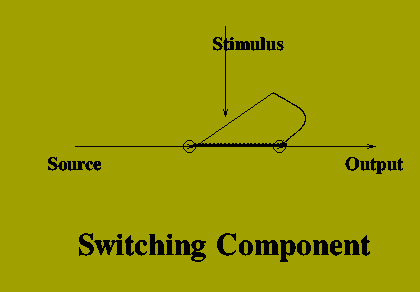

Using electrically driven switches we can
-
represent numbers (using binary notation)
-
perform calculations on these (e.g. addition, multiplication and more complex functions)
by providing an appropriate network of switching components.
-
Store and execute programs by expressing programming tasks as a sequence of basic operations
on data and realising these operations by switching networks.
One might argue that all of these could (in principle) be done mechanically, however, the
use of gearing mechanisms does not enjoy many of the advantages of systems built as outlined above:
-
Binary systems have only two values to represent; so such systems would be less likely
to suffer from failures.
-
Using electricity as the source of power allows for much faster systems.
Using binary as the basic representation means that:
-
the computational representation of a quantity is more flexible;
-
the processing of such representations can be described in a
concise algebra and therefore replicated.
All modern computing systems can, at the most basic
level of operations, be described in terms of complex networks of binary switching components.
The first such `switching components' were electro-mechanical relay-contact switches.
These comprised two metal contacts connected by a hinge; on receipt of a sufficiently high
voltage the two metal contact closed together to allow a current to pass through them.
Almost all subsequent improvements in computer design (speed and reliability) have
come about through the invention of better (smaller, faster, more reliable)
switching components: valves, transistors, LSI chips, VLSI chips.
Development of First Electrical Machines
in Germany (1936-44)
Konrad Zuse and Helmut Schreyer
Konrad Zuse (1910-) was a German electrical engineer who became interested
in designing automatic computers while a student in Berlin. Zuse initially
wished to build a machine to solve systems of simultaneous linear equations,
e.g.
3x + 2y + 3z = 18
5x + 3y + 2z = 17
4x + 6y + 7z = 37
where one is required to find (usually, unique) values for the k variables which simultaneously satisfy the
k identities.
In the example, the (unique) solution is x=1, y=2, and z=3.
Such systems
commonly arise in engineering applications as a model for representing trade-offs between different
criteria in building structures, e.g. weight, strength, rigidity etc of materials used.
Although not mathematically difficult to solve considerable amounts of calculation
are involved. The traditional approach (known as Gaussian elimination) becomes extremely laborious
when more then four identities are to be dealt with.
In engineering applications such as architecture
systems involving several hundred equations often arose and constructing feasible solutions
to such systems would require months of work by a number of teams.
Zuse had the
idea of carrying out the required calculations by a machine while he was a student in 1934. Zuse recognised
that such a machine would need to meet three basic criteria.
-
The machine would have to be as general as possible, i.e. not only deal with basic arithmetic
or even simultaneous equations but with any suitably formulated series of calculations.
To this end Zuse designed the machine to have a very similar structure to that proposed for
the Analytic Engine by Babbage:
-
Memory for recording data,
-
an arithmetic unit
-
a control unit
-
program unit for entering instructions and data
-
an output unit for printing results.
-
Binary representations of data would be used.
-
The operations of the machine were described and implemented using a formulation
of Boolean algebra.
In 1936, while working at the Henschel Aircraft Company in Berlin, Zuse started to build his
first machine: the Z1. This was undertaken entirely privately at his own expense.
This was completed in 1938, however, the arithmetic unit did
not function correctly. Zuse was still using a basically mechanical
system.
With his second machine, the Z2, in which Zuse dispensed with
the mechanical plates of his prototype machine (except for the memory design which had worked
successfully in the Z1) and substituted electromechanical relays instead.
This had two effects:
-
the machine worked;
-
it operated (for the time) extremely quickly.
The suggestion
that electro-mechanical relay switches be used had come from Zuse's colleague, Helmut Schreyer,
an electrical engineer.
Schreyer had actually proposed
using a purely electronic device
called a thermionic valve (similar to the valves found in old wireless sets).
This could be used both
as a memory device and as a switching mechanism.
Schreyer's idea was eventually taken up in the early 1950s
by prototype British and U.S. computers.
The final version of the Z2 was completed in 1939.
Zuse was conscripted at the outbreak of the Second World War eventually ending up working
at the Aerodynamics Research Institute. Schreyer, who was not conscripted, continued on his
own idea of building a machine using purely electronic components, in this case thermionic valve.
In 1942, Schreyer submitted a
research proposal describing his machine and its potential to the German High Command: it was
rejected as being of no importance.
Zuse was only able to work on his next machine, the Z3,
by presenting it as a special-purpose calculator for aircraft design.
The Z3, which was the first ever working
general-purpose programmable computer was completed in December 1941.
The machine which comprised a tape reader, operators console and functional
units containing about two and a half thousand relays was built for very little cost,
about po1000
Zuse went on to built a larger machine, the Z4, which after being relocated a number of times
during its construction to avoid bombing attacks, was completed in the late 1940s. It was subsequently
placed in a technical institute in Zurich in 1950 were for a number of years it was the
only available powerful calculating tool in mainland Europe.
The Z3 was destroyed by an air-raid on Berlin in April 1945.
Computers in the U.S. of A.
Aiken, Atanasoff, Eckert, Mauchley
and von Neumann
1937-1955
The history of electronic computer development in the U.S. is
extremely involved and (still) the subject of some controversy.
Most of this is caused by the roles of three of the participants
in the development:
-
John Atanasoff (1904-)
-
J. Presper Eckert (1929-)
-
John Mauchly (1907-1980)
The last two were at the centre of a Patents Dispute (under which
they claimed to have `invented' the first modern electronic computer).
In one form or another this dispute occupied various U.S. Courts from
1952 until October 19th 1973. It ended when the Supreme Court ruled
against Eckert and Mauchly's claim.
In fact, historically, Eckert and Mauchly's assertion to be the inventors
of the electronic computer has little to justify it.
The work of Zuse and
Schreyer predates their efforts by at least 5 years.
It is also the case that
British work in the 1940s has at least as strong a claim as Eckert and
Mauchly's.
Zuse's work was unknown in the U.S until much later.
British work was classified and details of it were only available from 1975.
The first U.S. figure to deal with digital electronic computers was
Howard Aiken.
Aiken in 1937 at Harvard proposed a structure for what he regarded as
an `ideal' computer.
This combined elements of Babbage's ideas together with Hollerith's
punched card techniques.
Aiken's proposals attracted support from I.B.M. His machine, the Mark 1,
was built between 1939 and 1944.
It used electro-mechanical relays, contained 3/4 million components, and
could complete a month's manual calculation in a single day.
John Atanasoff and his collaborator Clifford Berry produced a design for
a valve-based computer.
Atanasoff constructed a simple electronic calculator and set about
building a full-scale computer.
Only sections of this were completed though.
The Atanasoff-Berry Computer (ABC) was rediscovered in the 1960s.
Despite the fact that it was never built, this discovery played an
important r&ole in the subsequent Patent judgement against Eckert
and Mauchly.
Eckert and Mauchly
Mauchly, as with Shreyer and Atanasoff, was interested in employed valves
as a switching component for electronic computers.
His primary interest was in weather forecasting and the possibility of
carrying this out by a machine.
Eckert and Mauchly met at the Moore School in Pennsylvania and in May 1943
persuaded the U.S. Government to fund the construction of a digital computer.
The final machine, called ENIAC, was completed in May 1944. It was extemely
large (3000 cubic feet, 30 tons weight, 100,000 components); and very fast
being able to multiply in 3 milliseconds.
Eckert and Mauchly went on to found their own company.
John von Neumann
von Neumann was involved in the design of the successor to ENIAC, EDVAC,
which made a number of technical improvements upon ENIAC.
He is, mistakenly, credited as the inventor of the digital electronic computer.
von Neumann is mainly important for two achievements
-
He popularised and promoted the concept of applying computers to diverse applications.
-
He put forward a theoretical model of computer structure - the von Neumann model -
which described the organisation of component parts in electronic digital machines.
Developments in the U.K.
COLOSSUS to EDSAC
In 1938, the British Intelligence Service obtained a complete description
of the German cipher machine ENIGMA.
This was used to communicatew field orders by the German Military High Command.
Possession of the machine was not sufficient, in itself, to decipher intercepted
communications, since the machine encoded using a code sequence that was changed
daily.
Knowledge of the machine's operation, however, enabled the number of possible
keys available at a particular time to be greatly reduced.
The initial British attempts to build a (special-purpose) digital computer
took place at Bletchely Park under the direction of Alan Turing.
The aim of the research em codenamed Project ULTRA em was to build a
machine that could identify the codewords used to configure ENIGMA.
The final machine em called COLOSSUS em was started in January 1943
and completed in December 1943. A succesor, the Mark II, had been built
by December 1944.
This research and its results were not made public until 1975, under
the 30 Year Rule governing the release of classified material.
After the end of World War 2, British engineers made use of U.S. work
and a number of succesful systems were built:
-
Maurice Wilkes, at Cambridge, built the EDSAC computer. This was the first
stored program machine and the first to use an assembly language.
EDSAC was the first computing service in the world.
-
Wilkes also assisted Lyons Tea Company in designing LEO, an accounting and
record keeping computer system.
-
The first of a long series of machines, the Mark 1, was built at Manchester
University between 1947-49.
-
Turing went on to design the ACE computer at NPL in Teddington, which
it was hoped would provide a national computing facility.
-
In 1947 Turing left NPL to work on the Pilot ACE. This machine introduced
a number of important ideas. Although operational by 1952, not all of
Turing's innovations had been realised. Turing died in 1954 before
any further work on the Pilot ACE had been completed.
Lecture 6
Making Computing Easier
The Development of High-Level Programming Languages 1955-1970
Using a computer system in the early 1950s would often be an extremely
frustrating experience.
There were two causes of this:
-
The technology of the machines.
-
The problem of describing the task to be carried out, in a form
that the system could operate upon.
The technological problem was caused by the use of valves:
-
Valves consume a lot of power.
-
Valves therefore generate heat.
-
When a valve gets too hot, it burns out.
For the earliest machines, hours could be spent in setting up a series of
calculations, only to for the machine to have a valve failure (losing all
the data) when the program was run.
Although dealing with heating continues to be a problem for computer
systems the reliability of basic switching components greatly improved
after the invention of the transistor in 1947.
The TRADIC, built in 1954, was the first transistor-based computer.
Developments in semiconductor techniques and device physics eventually
led to the appearance of VLSI chips in the mid-1970s.
On these, a computer processor of far greater power than the 1940s machines
could be placed in a space the area of a fingernail. The first machines
typically occupied the space of several gymnasia.
The problem of making computer systems more accessible, however, was a far
less tractable one.
John von Neumann, in his description of computer organisation, had shown how
operations and data could be encoded in binary using a single word
of the computer memory.
The processor would then decode the binary instructions and execute the
specified command.
For the first computer systems, a complete program of binary instructions
would have to be fed into the machine by hand.
Even for quite simple programs this might necessitate entering several
thousand 0s and 1s. A single error would render the program useless.
Maurice Wilkes' invention of assembly language, whereby simple mnemonics
where used for program instructions (ADD, STORE, LOAD) helped a little in
avoiding such transcription errors.
Such programs were still difficult to write and still had to be translated (by hand)
into a form that could be entered into a computer.
High-level programming languages were developed to allow programs to be described
in more natural way. A single statement in a high-level language would correspond to
several machine instructions. A special program, called a compiler, was used
to translate such programs into a form that a computer could run.
In this lecture we examine the first languages developed and their
specific areas of application.
-
FORTRAN
-
COBOL
-
LISP
-
ALGOL60 and ALGOL68
FORTRAN
(FORmula TRANslation)
-
Developed in the mid-1950s.
-
Intended for scientific and numerical computation.
-
First compilers which seriously attempted to produce efficient code.
-
Supported by I.B.M.
-
Still widely used today.
-
Several revisions of initial design, but in principle, all
original FORTRAN programs will compile on later versions.
Readability and efficiency were important considerations in the design of FORTRAN.
COBOL
(COmmon Business Oriented Language)
-
Designed in late 1950s by Admiral Grace Hopper. Commissioned
by U.S. Navy.
-
Intended for commercial data processing applications.
-
Attempts to imitate English language. So extremely verbose.
e.g. A = B+C in FORTRAN become
ADD B TO C GIVING A
in COBOL.
Despite its attempts to mimic natural language, writing COBOL programs
was as difficult as writing in any other programming language. This led
to the realisation that the difficulty with programming computers is not
in describing the details of the program but in constructing the
algorithm which the program will encode.
LISP
(LISt Processing Language)
-
Developed by John McCarthy at M.I.T. in 1960.
-
Based on the lambda-calculus of Alonzo Church, hence readability was
not a consideration of the design.
-
First example of the class of so-called functional languages.
-
One of of the first languages to utilise `recursion' as a control feature.
-
Extremely popular in A.I. applications.
ALGOL60 and ALGOL68
(ALGOrithmic Language)
-
ALGOL60 designed by international committee in 1958.
-
Introduced many radical new ideas into Programming Language Theory.
-
General-purpose, but primarily meant for scientific applications.
-
Although widely used in universities was never adopted by industry; now
effectively extinct.
-
ALGOL68 designed by international committee convened in mid-1960s.
-
Greatly extended functionality of ALGOL60 and improved some design
features.
-
Notoriously difficult to construct compilers for: first two implementations
both in U.K. em one at Liverpool University.
-
Hardly used nowadays.
 PED Home Page
PED Home Page